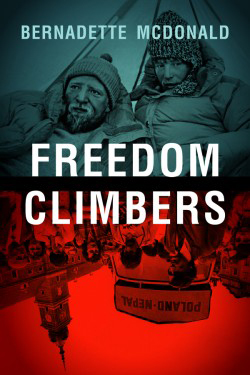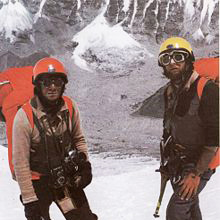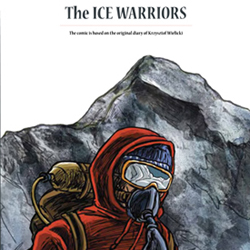 By Bernadette McDonald
By Bernadette McDonald
Victoria, Vancouver, Calgary: Rocky Mountain Books, 2011
352 pages
In 1996, Himalayan adventures – or rather misadventures – were all in the news. That year, a total of fifteen climbers perished on Mt. Everest, making it the deadliest season ever on the world’s highest peak. In his bestselling book Into Thin Air, Jon Krakauer – a journalist following one of the teams – painted a damning picture of the latest fad in mountaineering. Everest had become the playground of wealthy individuals eager to pay big money for bragging rights to what had once been the domain of a skilled and fortunate few: to have been on the top of the world. Under the solicitous care of countless professional guides and large teams of Sherpas setting up high-altitude camps and fixing ropes, pampered and often grossly unqualified (albeit professionally outfitted) climbers could realize their dreams. As the debacle of 1996 demonstrated, many participants had underestimated the elemental danger that high-altitude climbing always presented. The crass commercialization of modern-day Everest summits no less threatened to cheapen what was once a singular achievement.
How refreshing, then, to read a different – inspiring – story of mountain conquest. Freedom Climbers presents the incredible history of Poles on the top of the world. Those unfamiliar with the history of high-altitude climbing may be surprised to learn of the distinguished and often stunning achievements of Polish climbers after World War II, climbers who figured among the international elite and set numerous world records in the Alps, Karakoram, Hindu Kush, as well as the Himalayas. Nor were the Poles seeking an easy way up the mountains: many of their no-frills yet innovative Himalayan expeditions took place in the dead of winter, without Sherpas, without fixed lines, even without oxygen.
Hard to put down, Freedom Climbers is expertly and engagingly penned by Bernadette McDonald, the author of a number of prize-winning books on mountaineering. This time she has painstakingly pieced together a story of the over two decades of Himalayan exploits of Polish climbers, women as well as men, many of whom she knew personally. The figures and events of the glory days of Polish mountaineering are brought vividly to life. Both story and book are fully deserving of the years of attention lavished on them. A sign that McDonald’s effort has been appreciated by more than the present reviewer: Freedom Climbers has already won three prestigious book awards, has been translated into Polish and is being translated into other languages.
An event of 1996, recounted in the book, gives a sense of the chasm separating the golden age of Polish dominance in the Himalayas from the current state of international commercialized climbing. Only months after the Everest tragedy, a Polish climber named Krzysztof Wielicki completed his summit of all fourteen of the world’s peaks over 8000 meters high – the so-called Himalayan Crown. He was the fifth person – and second Pole – to do so. The achievement is all the more remarkable for how the Polish climber did it: Wielicki summitted his fourteenth peak, Nanga Parbat, in a solo climb, a mere twenty days after conquering the fearsome K2.
This achievement of 1996 essentially marked the end of the heroic phase of high-altitude climbing, one dominated by highly competent and highly competitive international climbers. The Polish climber was but one of many legendary figures in the mountaineering world. That said, his Himalayan baptism, at the age of thirty in 1980, had been stunning. Part of a two-man Polish team, Krzysztof Wielicki had made the first ever summit of Mt. Everest in winter. His burning desire to climb occasionally outweighed even pressing health concerns: instead of recovering from a back injury, in 1988 he made the first winter ascent of Lhotse, solo – his one nod to mortality being the stiffened corset he wore to keep his spine rigid.
Readers who imagine that Wielicki and his superhuman achievements lay at the center of McDonald’s book would nonetheless be wrong. He is but one hero of many, all representing the collective body of indomitable postwar Polish climbers, the title’s “Freedom Climbers.” Born during or following World War II, these Poles surmounted hurdles that climbers from the west could hardly imagine. Living in an unfree country – communist-ruled Poland – they surmounted difficulty after difficulty to become the dominant climbing dynasty. McDonald is sensitive to the particular circumstances that shaped Polish high-altitude climbing: the chronic shortages of food supplies and nonexistence of proper alpine equipment within Poland, the insufficient funds to cover international travel and expenses even when climbers were granted permission to leave the country, the disconnect between the communists’ penchant for control and the alpinists’ premium on freedom. The best Polish climbers were masters of the art of the seemingly impossible. Unafraid of taking risks, they bent rules back home as well as abroad (for example, engaging in black market trading on an international scale to finance their trips) in order to be able to reach the rarified realm of the mountains, where they felt truly alive.
At the same time, this is a story of individuals and their particular trajectories, tragic as well as triumphant. The life stories of three major Polish climbers get especial attention; their biographies are seamlessly woven throughout the narrative. The most famous Polish climber was the strong, driven, and ambitious Jerzy (Jurek) Kukuczka, the second man and first Pole ever to complete the Himalayan Crown – only a year after the South Tyrolean Reinhold Messner. Although second in the race to summit all fourteen of the 8000-ers, Kukuczka’s achievement was no less formidable: he climbed the Himalayas more ambitiously, in the winter and attempting new routes, and in half the time it took Messner. It should be noted that winter climbs were a striking innovation – even hallmark – of the latecomer Poles, who due to political reasons had no access to the Himalayas when, between 1950 and 1964, climbers from other countries were making the first ever ascents of the giants.
Another figure followed closely by the author is Kukuczka’s sometime climbing partner and temperamental opposite, Voytek (Wojciech) Kurtyka. The articulate and aesthetic Kurtyka became famous as a climber’s climber. Uninterested in “peak-bagging,” he specialized in challenging climbs that required technical lines and creative solutions. Like many of the Polish climbers, he preferred to climb in small groups, with minimal equipment; he also saw a spiritual side to climbing. Unlike many (including Kukuczka, whose obsession with conquering the never before scaled South Face of Lhotse proved fatal), Kurtyka miraculously managed to walk away from the mountains before they exacted from him the ultimate price.
Any discussion of Polish Himalayan exploits would be incomplete without mention of the first Pole and first European woman ever to summit Everest, Wanda Rutkiewicz. Her ascent of Everest incredibly took place on the same day in 1978 that her countryman (and inveterate hiker) Karol Wojtyła was elected Pope John Paul II. As a female climber, Rutkiewicz was an anomaly in a heavily male preserve; yet she managed to summit eight of the fourteen 8000-ers, and was the first woman (and, again, the first Pole) to conquer K2. Clearly captivated by the complex Rutkiewicz – beautiful, stubborn, confrontational, internationally renowned, often lonely (despite being twice married), ultimately tragic – McDonald makes her the central figure of the book.
Readers of Freedom Climbers come to feel that they know Jurek, Voytek, and Wanda, their foibles as well as their strengths. Their private lives were irrevocably altered, if each in its own way, by their obsession with climbing. The price they paid was high, if the goal no less lofty. The author contextualizes their achievements in the mountains by providing insight into their experiences in Nazi- and Soviet-occupied as well as communist-dominated Poland. Here the reviewer (a historian) might quibble with the occasional historical miscue or mistranslation, hardly unexpected from an author who, while an expert on the subject of mountaineering, had no prior contact with either Polish history or the Polish language.
What is somewhat more surprising is McDonald’s lack of understanding where this special Polish interest in climbing mountains came from. After all, what possessed a people quintessentially identified with flatlands or plains (pola, whence the etymology of the country’s name) to scale the mountain heights in far-off lands? McDonald looked no further back than the interwar period for the beginnings of Polish mountaineering, although at one point she made mention of the mountaineers’ hut at the lake known as Morskie Oko, high up in the Tatra Mountains on Poland’s southern border, that served as a “spiritual hub” for postwar climbers (p. 32).
Indeed: the Polish interest in scaling mountain peaks long predates the interwar period. The first Polish alpine organization, the Tatra Association, was founded in 1873. It had built its first hut at Morskie Oko as early as 1874 and published a yearbook popularizing mountain exploits from 1876. A subsection of the Tatra Association dedicated to technical mountain climbing was founded in 1902/3; its own periodical, Taternik (The mountaineer), dated from 1907. It is worth noting that these organizations and publications emerged in yet another, unfree period for the Poles, the period of partition (1795-1918), when there was no Polish state. Under foreign (imperial) rule – not unlike under communist rule – the mountains were where freedom resided.
Had McDonald known of this historic Polish coping mechanism, in which the lack of national freedom spurred Poles to enact freedom in the mountains, the tapering off of interest in mountaineering in Poland after 1989 would not have seemed so surprising. After the collapse of communism, Poland was free. Its citizens had less reason to heed the advice of the nineteenth-century scientist and poet, Wincenty Pol, who exhorted his compatriots in words that would become the Tatra Association’s motto: “To the mountains! To the mountains, dear brother! There freedom awaits you!”
These criticisms are not meant to detract from the enormous merits of this book. Bernadette McDonald is to be commended for telling this quintessentially Polish story, and telling it so well. Freedom Climbers is also lavishly illustrated. The dozens of photographs, both color as well as older black-and-white, are alone worth the price of the book.
CR




Pingback: The Warsaw Uprising: A Noncombatant Survivor’s Memoir
Pingback: Welcome to Winter 2016!
Pingback: Climbing Mountains, in Pursuit of Freedom - Cornell University Press